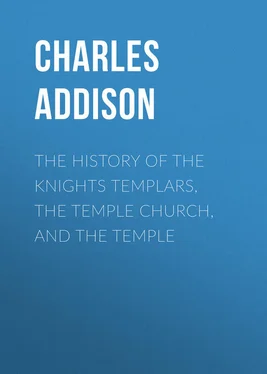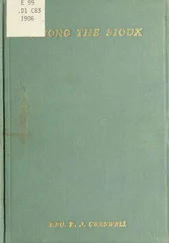Charles Addison - The History of the Knights Templars, the Temple Church, and the Temple
Здесь есть возможность читать онлайн «Charles Addison - The History of the Knights Templars, the Temple Church, and the Temple» — ознакомительный отрывок электронной книги совершенно бесплатно, а после прочтения отрывка купить полную версию. В некоторых случаях можно слушать аудио, скачать через торрент в формате fb2 и присутствует краткое содержание. Жанр: foreign_antique, foreign_prose, на английском языке. Описание произведения, (предисловие) а так же отзывы посетителей доступны на портале библиотеки ЛибКат.
- Название:The History of the Knights Templars, the Temple Church, and the Temple
- Автор:
- Жанр:
- Год:неизвестен
- ISBN:нет данных
- Рейтинг книги:5 / 5. Голосов: 1
-
Избранное:Добавить в избранное
- Отзывы:
-
Ваша оценка:
- 100
- 1
- 2
- 3
- 4
- 5
The History of the Knights Templars, the Temple Church, and the Temple: краткое содержание, описание и аннотация
Предлагаем к чтению аннотацию, описание, краткое содержание или предисловие (зависит от того, что написал сам автор книги «The History of the Knights Templars, the Temple Church, and the Temple»). Если вы не нашли необходимую информацию о книге — напишите в комментариях, мы постараемся отыскать её.
The History of the Knights Templars, the Temple Church, and the Temple — читать онлайн ознакомительный отрывок
Ниже представлен текст книги, разбитый по страницам. Система сохранения места последней прочитанной страницы, позволяет с удобством читать онлайн бесплатно книгу «The History of the Knights Templars, the Temple Church, and the Temple», без необходимости каждый раз заново искать на чём Вы остановились. Поставьте закладку, и сможете в любой момент перейти на страницу, на которой закончили чтение.
Интервал:
Закладка:
Having given an outline of the great territorial possessions of the order of the Temple in Europe, it now remains for us to present a sketch of its organisation and government. The Master of the Temple, the chief of the entire fraternity, ranked as a sovereign prince, and had precedence of all ambassadors and peers in the general councils of the church. He was elected to his high office by the chapter of the kingdom of Jerusalem, which was composed of all the knights of the East and of the West who could manage to attend. The Master had his general and particular chapters. The first were composed of the Grand Priors of the eastern and western provinces, and of all the knights present in the holy territory. The assembling of these general chapters, however, in the distant land of Palestine, was a useless and almost impracticable undertaking, and it is only on the journeys of the Master to Europe, that we hear of the convocation of the Grand Priors of the West to attend upon their chief. The general chapters called together by the Master in Europe were held at Paris, and the Grand Prior of England always received a summons to attend. The ordinary business and the government of the fraternity in secular matters were conducted by the Master with the assistance of his particular chapter of the Latin kingdom, which was composed of such of the Grand Priors and chief dignitaries of the Temple as happened to be present in the East, and such of the knights as were deemed the wisest and most fit to give counsel. In these last chapters visitors-general were appointed to examine into the administration of the western provinces.
The western nations or provinces of the order were presided over by the provincial Masters, 158 158 The title Master of the Temple was so generally applied to the superiors of the western provinces, that we find in the Greek of the lower empire, the words Τέμπλου Μαιστὼρ. Ducange. Gloss.
otherwise Grand Priors or Grand Preceptors, who were originally appointed by the chief Master at Jerusalem, and were in theory mere trustees or bare administrators of the revenues of the fraternity, accountable to the treasurer general at Jerusalem, and removeable at the pleasure of the Chief Master. As the numbers, possessions, and wealth of the Templars, however, increased, various abuses sprang up. The members of the order, after their admittance to the vows, very frequently, instead of proceeding direct to Palestine to war against the infidels, settled down upon their property in Europe, and consumed at home a large proportion of those revenues which ought to have been faithfully and strictly forwarded to the general treasury at the Holy City. They erected numerous convents or preceptories, with churches and chapels, and raised up in each western province a framework of government similar to that of the ruling province of Palestine.
The chief house of the Temple in England, for example, after its removal from Holborn Bars to the banks of the Thames, was regulated and organised after the model of the house of the Temple at Jerusalem. The superior is always styled “Master of the Temple,” and holds his chapters and has his officers corresponding to those of the chief Master in Palestine. The latter, consequently, came to be denominated Magnus Magister
Конец ознакомительного фрагмента.
Текст предоставлен ООО «ЛитРес».
Прочитайте эту книгу целиком, купив полную легальную версию на ЛитРес.
Безопасно оплатить книгу можно банковской картой Visa, MasterCard, Maestro, со счета мобильного телефона, с платежного терминала, в салоне МТС или Связной, через PayPal, WebMoney, Яндекс.Деньги, QIWI Кошелек, бонусными картами или другим удобным Вам способом.
1
Elmacin, Hist. Saracen. Eutychius.
2
Ingulphus, the secretary of William the Conqueror, one of the number, states that he sallied forth from Normandy with thirty companions, all stout and well-appointed horsemen, and that they returned twenty miserable palmers, with the staff in their hand and the wallet at their back. — Baronius ad ann. 1064 , No. 43, 56.
3
Will. Tyr. , lib. i. cap. 10, ed. 1564.
4
Omnibus mundi partibus divites et pauperes, juvenes et virgines, senes cum junioribus, loca sancta visitaturi Hierosolymam pergerent. – Jac. de Vitriaco. Hist. Hierosol. cap. lxv.
5
“To kiss the holy monuments,” says William of Tyre, “came sacred and chaste widows, forgetful of feminine fear, and the multiplicity of dangers that beset their path.” – Lib. xviii. cap. 5.
6
Quidam autem Deo amabiles et devoti milites, charitate ferventes, mundo renuntiantes, et Christi se servitio mancipantes in manu Patriarchæ Hierosolymitani professione et voto solemni sese astrinxerunt, ut a prædictis latronibus, et viris sanguinum, defenderent peregrinos, et stratas publicas custodirent, more canonicorum regularium in obedientia et castitate et sine proprio militaturi summo regi. Jac. de Vitr. Hist. Hierosol. apud Gesta Dei per Francos , cap. lxv. p. 1083. — Will. Tyr. lib. xii. cap. 7. There were three kinds of poverty. The first and strictest ( altissima ) admitted not of the possession of any description of property whatever. The second ( media ) forbade the possession of individual property, but sanctioned any amount of wealth when shared by a fraternity in common. The lowest was where a separate property in some few things was allowed, such as food and clothing, whilst everything else was shared in common. The second kind of poverty (media) was adopted by the Templars.
7
Pantaleon , lib. iii. p. 82.
8
D’Herbelot Bib. Orient. p. 270, 687, ed. 1697. William of Tyre, who lived at Jerusalem shortly after the conquest of the city by the Crusaders, tells us that the Caliph Omar required the Patriarch Sophronius to point out to him the site of the temple destroyed by Titus, which being done, the caliph immediately commenced the erection of a fresh temple thereon, “Quo postea infra modicum tempus juxta conceptum mentis suæ feliciter consummato, quale hodie Hierosolymis esse dinoscitur , multis et infinites ditavit possessionibus.” – Will. Tyr. lib. i. cap. 2.
9
Erant porro in eodem Templi ædificio, intus et extra ex opere musaico, Arabici idiomatis literarum vetustissima monimenta, quibus et auctor et impensarum quantitas et quo tempore opus inceptum quodque consummatum fuerit evidenter declaratur… In hujus superioris areæ medio Templum ædificatum est, forma quidem octogonum et laterum totidem, tectum habens sphericum plumbo artificiose copertum… Intus vero in medio Templi, infra interiorem columnarum ordinem rupes est, &c. — Will. Tyr. lib. i. cap 2, lib. viii. cap. 3. In hoc loco, supra rupem quæ adhuc in eodem Templo consistit, dicitur stetisse et apparuisse David exterminator Angelus… Templum Dominicum in tanta veneratione habent Saraceni, ut nullus eorum ipsum audeat aliquibus sordibus maculare; sed a remotis et longinquis regionibus, a temporibus Salomonis usque ad tempora præsentia, veniunt adorare. — Jac. de Vitr. Hist. Hierosol. cap. lxii. p. 1080.
Читать дальшеИнтервал:
Закладка:
Похожие книги на «The History of the Knights Templars, the Temple Church, and the Temple»
Представляем Вашему вниманию похожие книги на «The History of the Knights Templars, the Temple Church, and the Temple» списком для выбора. Мы отобрали схожую по названию и смыслу литературу в надежде предоставить читателям больше вариантов отыскать новые, интересные, ещё непрочитанные произведения.
Обсуждение, отзывы о книге «The History of the Knights Templars, the Temple Church, and the Temple» и просто собственные мнения читателей. Оставьте ваши комментарии, напишите, что Вы думаете о произведении, его смысле или главных героях. Укажите что конкретно понравилось, а что нет, и почему Вы так считаете.
